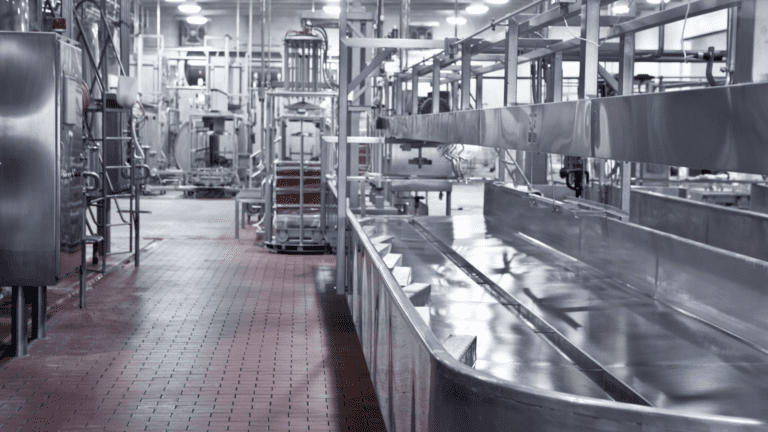 Food processing plants are among America’s biggest consumers of refrigeration power.
Food processing plants are among America’s biggest consumers of refrigeration power.
When you walk into the local grocery store and enjoy the blast of cool, conditioned air, you know you’re stepping into an environment with plenty of refrigeration equipment at work. In a food processing plant, it may be necessary to have double or triple the number of refrigeration compressors.
From fishsticks to frozen pizzas, prepared frozen foods are a major part of American life. If you’ve ever found yourself gazing into the freezer, wondering what’s for dinner – or needing a quick plan to feed the kids – then you know just how important this category is. And it all starts with refrigeration.
Food Processing Plants Throughout America Make Millions of Meals Each Month
Back in 2012, total output of the 100,000 square foot RMS Foods alternative meat plant was estimated at more than 35 million pounds of product. Back then, of course, no one could have predicted the trend of going “beyond meat” would lead to such a remarkable transformation.
RMS, then the #2 producer of alternative meat products, has continued to grow and prosper.
Not familiar with RMS? Maybe you know Don Miguel Mexican Foods, Inc. – a brand with a story reaching all the way back to 1906. Now part of the Hormel Foods portfolio, it all started with Alejandro Morales, an immigrant from Sonora, Mexico.
He began his journey selling his wife’s homemade tamales on the streets of Anaheim, CA. Naturally, that didn’t require too much refrigeration – only one day’s worth of food was produced at any given time, and it went fast!
More than a century later, Don Miguel has a number of prepared foods plants. Its Dallas plant employs more than 700 people making tacos, burritos, and other favorites. Parent company Hormel has facilities in Kansas and Illinois, too – later responsible for a range of bacon products.
And what about Bridgford Foods? The maker of pepperoni and meat snacks, bread and rolls, biscuits, and ready-to-eat sandwiches has been around since 1932. At a time when the global meat snacks market is on the incline, this is the kind of company poised to expand.
When it’s time to do so, food processing plants are taking a cue from allied industries. Dairy farms, meatpacking plants, and much more have been ramping up their refrigeration capacity over the last few years. To get the performance they can trust, many of them look to American-made Copeland compressor models.
Copeland Stands Out from the Crowd for a Variety of Reasons
Copeland Corporation has made a significant historic impact on its native Shelby County, Ohio. With a history dating back to 1937, its first successful mechanical refrigeration system is now showcased in Washington, D.C. at The Smithsonian. It is also known for its “Pollywog,” an early semi-hermetic compressor.
Food processing plants choose Copeland for a slew of reasons:
1. Copeland Compressors Are Reliable
Copeland compressors are among the most reliable on the market today. With appropriate maintenance, a commercial compressor can operate 8-10 years. Copeland compressor hardware consistently outshines the competition by maintaining higher levels of output and mechanical efficiency later in service life.
2. Copeland Compressors Are Easy to Maintain
Copeland has been setting the standard in refrigeration compressor technology for nearly a century. The brand has had plenty of time to establish and refine best practices. When you need to repair or maintain a Copeland, you will not have to deal with any surprises. To the contrary, these compressors are a pleasure to work on.
3. Copeland Combines Power and Efficiency
Food processing plants often need to get a substantial level of refrigeration output into a compact space that does not offer many options for re-configuration. Copeland compressors are powerful without taking up too much space. Plus, they will help you manage your energy consumption with superior efficiency.
4. Copeland Is an American Brand
There are many respectable commercial compressor brands that don’t originate in the United States. Still, there is something to be said for the shorter supply chain of a domestic firm. It is often easier to find the parts you need to repair your Copeland commercial compressor. More engineers are familiar with the brand, as well.
The Copeland 4DT2200TSK (also known as the Copeland 4DT3F7KETSK) stands out as a prime example of these qualities. Already widely used in agriculture, the Copeland 4DT2200TSK is making the jump to food processing plants. Driven by its availability as a remanufactured commercial compressor, it is becoming one of the most popular ways to achieve world class refrigeration performance at an affordable price.
Next time you open the fridge or freezer to take a peek, think of the work that goes into your favorite frozen foods – and the compressors, like Copeland, that make it all possible.












